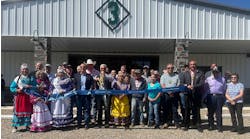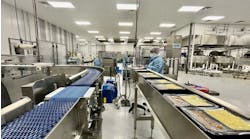Horace Greeley’s “Go West, young man” advice wasn’t about direction, it was about opportunity. If Horace was advising today’s food and beverage industry, something more along the lines of “Go gluten-free” would be his suggestion of where to invest capital.
Threshold levels of spending are necessary simply to stay in the game, and even the most financially stressed food and beverage companies commit one or two percent of sales to capital expenditures each year. Investments in big-ticket projects, on the other hand, go where the opportunities lie, and today’s opportunities are different than yesterday’s. The changes are reflected in the greenfield plants being built.
Craft beer, Kentucky bourbon and the only white meat are on Americans’ shopping lists, and capital is flowing to projects involving all three.
Get your copy of the 2015 Capital Spending Facts and Figures. Download Now
Our analysis of financial statements from 45 of the largest food and beverage companies turns up more than $21 billion in capital spending budgeted for 2015. That's 8 percent more than those same companies spent last year ($19.7 billion) and about the same as they budgeted – meaning, as a group, they underspent, which is not uncommon. Eight seems to be a magic number, as this group spent about 8.7 percent more in 2014 than they did in 2013.
Lactose intolerance and dairy-free milk are other dietary hot buttons, and the divergent fortunes of Whitewave and Dean Foods are a stark example of how that impacts capital spending.
Plant-based foods of all types and organic milk are fast growing categories, and WhiteWave’s capital expenditures are increasing at double-digit rates. Dean, on the other hand, was left with the fluid milk side of the business when WhiteWave was spun off in 2012. Milk sales are declining almost as fast as plant-based milks are growing, as reflected by the dozen dairies Dean has closed in recent years, with more to come. Dean’s ratio of capital spending to sales revenue is among the industry’s lowest.
Some of the biggest projects currently under way involve poultry. These processors are coming off a banner year, thanks in part to a moderation in feed costs but also because of shortages of other proteins. Porcine epidemic diarrhea virus severely impacted breeding programs and resulted in a shortfall of 8-9 million pigs coming to market in 2014, estimates William Sawyer, a food and agribusiness analyst with Rabobank International, New York.
Pork processors have put the problem in the rearview mirror, and America’s supermarkets soon will be awash in hams and pork chops. In the mean time, high beef prices are helping sustain chicken as a popular option for America’s dinner tables.
Today’s poultry building boom ends several years of inactivity. When market conditions soured in 2012, Sanderson Farms scrapped a greenfield poultry project in North Carolina. The firm recently opened a $124 million complex in Palestine, Texas, and announced a $139 million project in southeastern North Carolina.
An even more ambitious poultry project is under way in Arkansas, where Peco Foods is building a $165 million feed mill, hatchery and processing facility. And a $100 million brownfield in Millsboro, Del., involving a 470,000-sq.-ft. facility is awaiting a green light from Allen Harim LLC, a division of a Chinese holding company that acquired an old-line Delaware poultry processor four years ago. Natural and organic chicken supplier Bell & Evans is finalizing details of a construction project in Fredericksburg, Pa., that will double capacity by 2017.
Automation and market trends are sparking major investments in bourbon production. In the run-up to last year’s acquisition by Japan liquor giant Suntory, Jim Beam invested heavily in increased capacity and warehouse modernization and expansion. Brown-Forman Corp. did the same, more than doubling capital expenditures from 2012 to 2014, much of it going to its Jack Daniels Distillery. Tourism on the bourbon trail also was booming, and some of the funds went to visitor centers.
A crane lowers a 49,000-gal. fermentation tank into position at New Belgium Brewing’s new brewery in North Carolina. Production should commence by January. Photo: Oppenheim Photo
About half of U.S. distilled spirits are produced in Kentucky. Smaller bourbon producers in the state also are lavishing capital on capacity expansion and automation. The Sazerac Co., a private distiller associated with downscale brands like Fireball cinnamon whiskey, is plowing $71 million into warehouses equipped with automated storage and retrieval systems at Buffalo Trace and Glenmore, two of its Kentucky distilleries, plus capacity expansion at the Barton distillery. A $2.2 million expansion of the Buffalo Trace visitors center and tasting area also is in the works.
Less visible are the investments in boutique bourbon production. Ten-fold growth in craft distilling has occurred in the last decade, with hundreds more in the pipeline. “They’re buying historic buildings, converting them to boutique distilleries with a tasting room and gift shop,” reports Tyler Cundiff, senior manager-food and beverage business development at Lexington, Ky.-based Gray Construction. Likening it to the craft brewing segment, Cundiff views it as the perfect complement to the growth of major bourbon makers. “It has been explosive for the last few years,” he says, “and it’s not slowing down.”
Changing tastes and trends
The trend at some of the industry’s most venerable companies is less positive. Dwindling category-wide sales of chewing gum led to Wrigley’s recent announcement it would shutter is Toronto manufacturing facility in March 2016, with production shifting to Gainesville, Ga. H.J. Heinz also is rationalizing production in the wake of its acquisition by Berkshire Hathaway and 3G Capital [although before its announced merger with Kraft], with six announced plant shutdowns so far. One is a former Ore-Ida facility in Pocatello, Ida., which closed in June. Speaking of Kraft Foods, it plans to shutter a Woburn, Mass., facility by year end.
When one door closes, another opens. Americans may be french-fried out (a $100 million McCain Foods project in Idaho is on hold), but their appetite for natural and organic vegetables is increasing. The ammonia compressors in Pocatello had barely cooled when Amy’s Kitchen announced it would invest $76 million in the 500,000-sq.-ft. facility to produce frozen vegetarian meals. Production resumed in December.
Maxed out on capacity, Amy’s is riding one of the most aggressive growth curves in the industry. Last year’s sales far exceeded projections and would have been up 30 percent if the company could have kept up with orders. Besides the Idaho facility, the California-based company leased an additional 56,000 sq. ft. of production space in Santa Rosa, Calif., and added 130,000 sq. ft. to its Medford, Ore., plant. Amy’s also is building a greenfield in upstate New York, with a late 2016 start-up targeted.
An open campus look is one of the design considerations for Clif Bar’s Twin Falls, Idaho, bakery project, which begins construction next month. The 90-acre site also will accommodate an amphitheater, gardens and extensive open spaces.
Moving into Amy’s Idaho neighborhood will be Clif Bar & Co., an organic energy snack company that is building a bakery in nearby Twin Falls. A new-age food company, Clif Bar has followed a familiar path since its founding in 1992, functioning as a marketing organization without any manufacturing capacity. That will change next year, with the new facility providing greater product consistency, lower production cost and faster speed to market of innovative new products, according to spokesman Keely Wachs. Construction was scheduled to commence April 1.
While fast growth in both organic products and bar products should keep Clif’s bakery busy, mainstream industrial bakeries are struggling. The supermarket bread aisle is where flour goes to die. The president of George Weston Ltd. acknowledged as much in a recent conference call, saying the Toronto-based baker intends to shift focus from white bread and toward artisan and indulgent products sold through in-store bakeries. The firm intends to spend $470 million in 2015-16, primarily on “a couple of new greenfields” in the U.S., according to President Pavi Binning.
For multinational food companies, capital is being directed outside North America. A third of Hershey Co.’s capital expenditures this year will go to a new plant in Malaysia, bringing total investment in the facility to $265-275 million. The corporation’s total capital spending last year was $345.9 million.
Mondelez International continues to invest in North America. A greenfield opened in Salinas, Mexico, recently, and a new line in a Virginia mega-plant is expected to start up this month. But the real action is on other continents as the organization focuses on “changing our network around the world,” as Daniel Myers, EVP-integrated supply chain, told investors at a recent conference in Boca Raton, Fla.
By the numbers
New machinery and modern facilities are necessary for any manufacturer to remain competitive and to grow. Funding improvements typically rely on cash generated from operating activities. At all publicly traded companies and most private ones, capital expenditures compete with dividend payments, financing activities, acquisitions and other needs. Based on analysis of those 45 corporate financial reports, public food companies expended an average of 4.4 percent of sales on capital expenditures last year, ranging from 1.3 to 15.7 percent (download the chart for more information).
Process improvements rely on those fiscal line items. Those projects are far ranging and plant-specific, but a number of dairy processors are investing in whey process improvements. Isolation of specific elements adds significant value.
Glanbia Foods is adding whey protein isolate capabilities to its Idaho manufacturing complex. Davisco boasts of a novel processing solution in Jerome, Idaho, that will yield a 10-fold increase in 90-percent pure Alpha-lactalbumin. Calling it “an engineering marvel that required a substantial capital investment,” a spokesman says the high purity and tryptophan levels will allow Davisco to meet some of the accelerating demand for the ingredient from infant formula and nutritional beverage makers.
Shifting consumer expectations and market uncertainty are keeping many capital projects on hold, observes Mark Redmond, president of Cincinnati-based Hendon & Redmond Engineers. “There’s not much growth for the sake of growth anymore,” he says, but when profitable opportunities emerge, “the medium-size guys are a little more nimble” in seizing them.
Some of those opportunities: Same-store sales are declining at McDonald’s while Five Guys and other burger purveyors gobble market share. That creates an opportunity for bun bakers and other suppliers outside McDonald’s supply chain. They tend to be middle-market food companies.
Likewise, retailers capitalizing on the healthier-eating trend present an opportunity for nimble manufacturers. “Whole Foods is an amazing partner for some of those guys,” says Redmond, with the retailer extending financing for capital projects in some cases.
Sugarcreek Packing Co. exemplifies the mid-market food companies who identify opportunities and seize them. The 49-year-old Cincinnati-based copacker’s last new facility opened 30 years ago. That will change in July, when the $600 million firm moves into a $120 million facility in Cambridge City, Ind. A former 70,000-sq.-ft. food plant on the site was gutted and converted to office space, with 365,000 sq. ft. of brick and mortar added to accommodate three production lines, including a high-volume sous vide automated cook line. Infrared baking and impingement ovens will contribute to a 50 percent boost in network capacity.
Sous vide is well established in the restaurant trade, and packaged-goods manufacturers are interested in applying the technology, according to Rob Daly, CEO, but they won’t commission any lines until market acceptance is firmly established. “We want to partner with innovative food companies who are fighting to get to the perimeter of the store,” he adds. A number of them are engaged in concept testing at Sugarcreek’s pilot plant, including some of the industry’s most visible brands.
Sous vide plays to a number of trends, particularly healthy eating (higher nutrient retention) and restaurant-quality foods in a ready-to-eat format. Shrinkage during cooking is 20-30 percent less than from conventional processes, a yield advantage any protein supplier can appreciate. Sous vide also will expand Sugarcreek’s capabilities beyond raw and processed meat and into vegetables, particularly for baby food. “It’s transformational,” concludes Daly.
Financial aid
Food processors big and small that are considering major projects are being courted furiously by state and local economic development authorities. Assistance that might have been limited to red-tape cutting now goes well beyond to include job training, tax credits, outright grants and more.
Pennsylvania’s Clemens Food Group entertained offers from Ohio before accepting Michigan’s $55 million package of state and local assistance, including land acquisition. Joining Clemens in the project will be Cooper Farms, an Ohio turkey processor with hog operations. The plant, which will come on line in late 2016 or early 2017, will be the first pork processing facility for both Michigan and Cooper.
Land acquisition was part of a package pieced together in Philadelphia last year to keep Dietz & Watson in the city. After a fire destroyed the deli-meat company’s facility across the Delaware River, New Jersey tried to lure Dietz to the Garden State with a $30 million deal, conditioned on relocation of the firm’s headquarters as well. Pennsylvania state, federal and local authorities acquired 20 acres and resold 12 to Dietz to allow the processor to expand operations and add a distribution center.
That assistance pales in comparison to the city of Richmond, Va., which was locked in a fight with Norfolk, Va., and Columbus, Ohio, for an East Coast brewery for Stone Brewing Co. of Escondido, Calif. The country’s 10th largest craft brewer scouted two score of potential sites before settling on the final trio. Richmond won the competition when officials agreed to issue $30 million in bonds to finance almost half of the project cost.
Workforce training assistance was a lure in Clif Bar’s decision to build in southeastern Idaho, reflects Wachs, but there wasn’t anything extraordinary about the region’s aid package. “They’re table stakes, honestly,” he says, and fairly consistent from one community to another. He also discounts the appeal of low interest rates, saying, “For us, the decision to make this investment had less to do with the current lending environment and more on the projected growth for our food.”
Daly also downplays the influence of economic development authorities. “We didn’t run an auction, but we got great help from the state on economic development and training grants,” he says. “Interest rates are good, the investment environment is good, but we’re a private company, and part of the beauty of being private is you can act on your convictions and think in terms of a five-year horizon.”
The vast majority of food & beverage companies are private, and a large number of both private and public food manufacturers are cash-rich. When they embark on capital projects, they are driven by the opportunity those investments present.


